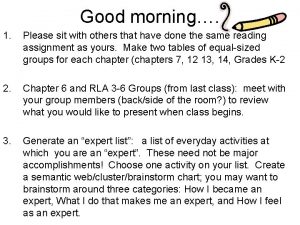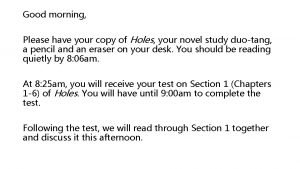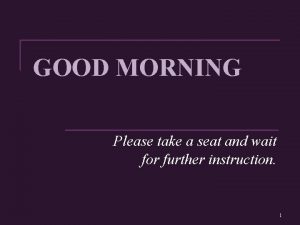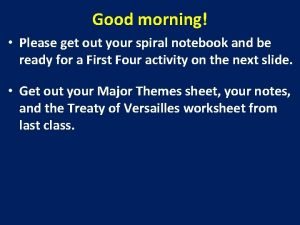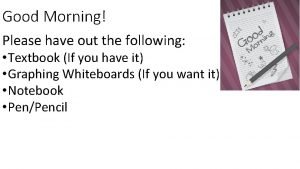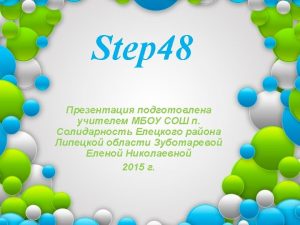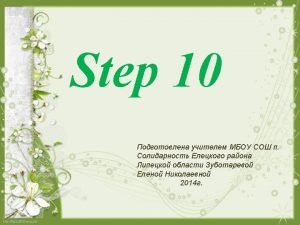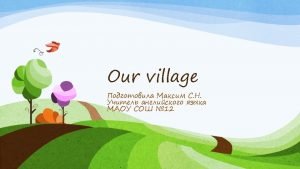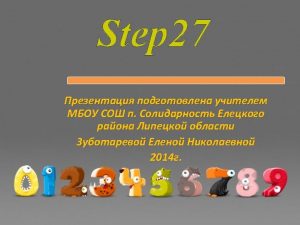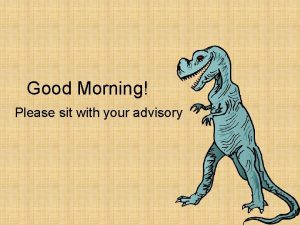Good morning 1 Please sit with others that













- Slides: 13

Good morning…. 1. Please sit with others that have done the same reading assignment as yours. Make two tables of equal-sized groups for each chapter (chapters 7, 12 13, 14, Grades K-2 2. Chapter 6 and RLA 3 -6 Groups (from last class): meet with your group members (back/side of the room? ) to review what you would like to present when class begins. 3. Generate an “expert list”: a list of everyday activities at which you are an “expert”. These need not be major accomplishments! Choose one activity on your list. Create a semantic web/cluster/brainstorm chart; you may want to brainstorm around three categories: How I became an expert, What I do that makes me an expert, and How I feel as an expert.

Goals • Consider the “fundamental” aspects of a writing program. • Discuss and synthesize readings. • Read your writing and respond to others’ writing. • Experience a modeled writing and a revision mini lesson.

Chapter 6 and RLA Framework 3 rd-6 th

Components of a Balanced Language Arts Program Reading Read aloud Guided Reading Writing aloud/ Modeled Writing Shared and Interactive Writing Guided Writing Independent Reading Independent Writing Shared Reading

Modeled Writing

Lesson Plan Goal 1. 0 Writing Strategies: 1. 1 Create a single paragraph with a topic sentence and supporting facts and details. Written and Oral Language Conventions 1. 6 Use of commas; includes commas in a series Objective Given a modeled writing mini lesson, students will provide a topic sentence and supporting details in their independent writing as measured by completed writing samples. Formative assessment Summative assessment Intro Procedure Closure

Modeled Writing Examples: • Ms. Garcia writes a "morning message" about what will be happening that day in terms of activities. As she writes, she thinks aloud while correctly writing in front of the students. • Ms. Washington writes on chart paper a personal experience "Yesterday I went to visit a zoo. I saw two adorable monkeys swing from tree to tree. " She models for students one form of topic choice for writing in their journals. • Mr. Brown models using a paragraph frame on an overhead or chart, to create his own written summary paragraph of a science text selection. • Mr. Morgan uses a Newsweek essay, “Inside the Classroom” as a patterned essay. He utilizes a “think aloud” as he develops his own essay using key words and the author's structure as a pattern.

Non-examples 1. The teacher makes mistakes for students to find and correct. (i. e. , DOL) 2. The teacher posts "daily news" on the chalkboard for students to read as they enter the classroom. 3. A group of students collaborate with the teacher on editing a class story. 4. The teacher presents a writing prompt or topic for students to respond. 5. Students develop and write their own conclusions to a story. 6. Students are required to look up and copy key vocabulary from a text selection.

Steps 1. Plan the lesson. 2. Introduction. 3. Write. 4. Reread. 5. Help students connect with presented concepts. 6. Review concepts presented. 7. Connect to classroom contexts.

What is “fundamental”? What concepts does Grave address?

Carousel, Part 1 POSTED, READY BY 11: 00 For sharing each chapter with your group, decide: • What is fundamental? • How can you teach it? • Where does it connect with the standards? • How will you know if English learners are making progress with respect to these “fundamentals”? Create a group poster that addresses each of these points.

Carousel, Part 2 • • One person will stay with the chart to explain/answer questions. Each group will start at the next chapter in # order. At the signal, move to the next chart (3 rotations). Another person returns to the chart to present/answer questions. Written reflection at the end.

For next time… Language Arts: Help Children Read and Write Fiction • Read: Graves, ch 18; Review ELD/ELA “Literary Response & Analysis” standards for your grade level • Write: Actions 18. 2, 18. 3, 18. 4 in order (these writings will be shared in class). • Look at the RICA website. Become familiar with the RICA domains and content areas.
 Cómo se dice buenas tardes
Cómo se dice buenas tardes Good morning class good morning teacher
Good morning class good morning teacher Good afternoon dear students
Good afternoon dear students Good morning everybody good morning everyone
Good morning everybody good morning everyone Good morning good morning to you i am glad to see you
Good morning good morning to you i am glad to see you C. good evening.
C. good evening. Good afternoon students
Good afternoon students Good morning sit
Good morning sit Good morning please
Good morning please Mr unimportant good morning
Mr unimportant good morning Good morning please have a seat
Good morning please have a seat Good morning please
Good morning please Theobald von bethmann hollweg
Theobald von bethmann hollweg Good morning please have a seat
Good morning please have a seat








